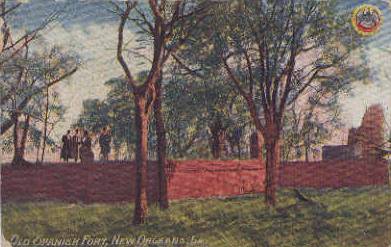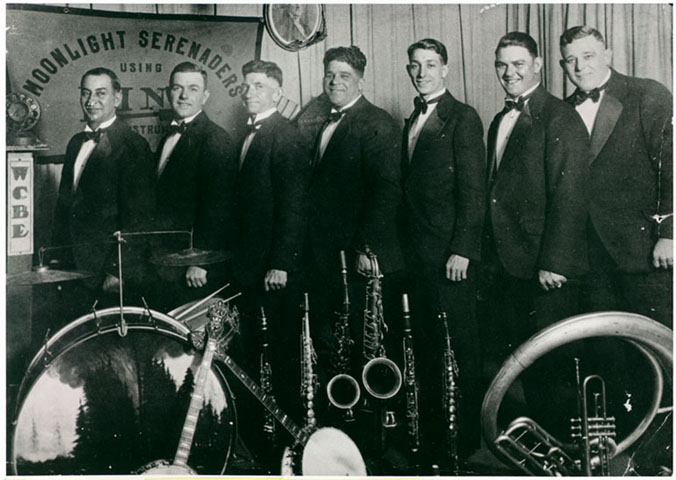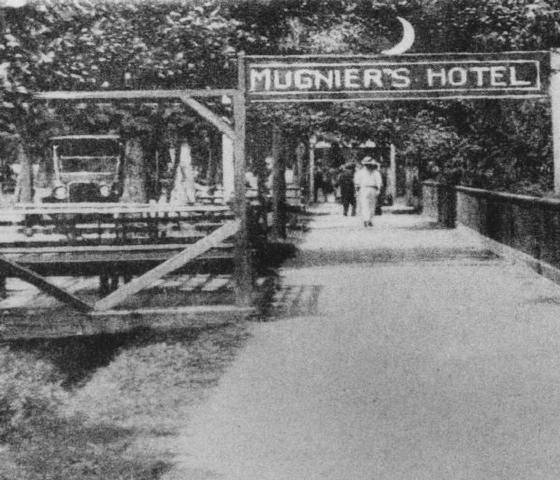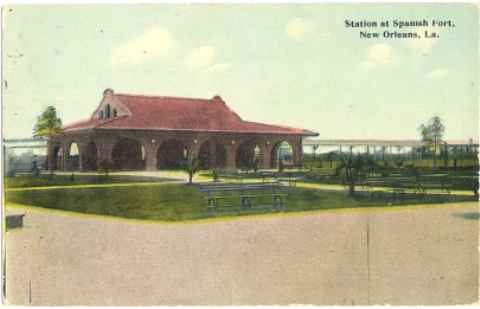|
Unknown Dates (1910)
Cabildo - home to the Louisiana Supreme Court from 1868 to 1910 and was the site of the controversial. “separate
but equal” ruling by the state’s high ...
Many more Italians emigrated to New Orleans in the mid to late 1800s, fleeing persecution and poverty. By the end of the 1890s
more than 30,000 Italians had entered New Orleans, and by 1910 a mass migration from Sicily transformed the French Quarter
into “Little Italy.”
Shotgun House
1850-1910.
The Supreme Court under Edward Douglass White, 1910-1921 -- was in White League
Lived in New Orleans, 1910-1919: Norwood F. Allman - Martin Behrman - Louis H. Burns - Walter L. Cohen - Milton J. Cunningham - John Depinet - H. Garland Dupré - John Ewing - Robert Ewing - Samuel L. Gilmore - Emile Kuntz - David A. Lines - Victor Loisel - Francis T. Nicholls - Joseph A. O'Hara - Armand Romain - James M. Thomson
Loyola University- New OrleansFrom Wikipedia, The Free Encyclopedia Loyola University New Orleans is a private, co-educational
and Jesuit university located in New Orleans, Louisiana. Originally established as Loyola College in 1904, the institution
was later chartered as a university in 1912. The first of Loyola's permanent buildings was undertaken in 1907, with
Marquette Hall completed in 1910.
Joe Jackson cardStarting Bid - $5,000.00, Sold
For - $92,800.00
http://www.robertedwardauctions.com/auction/2005/8.html#photos
racial makeup http://74.125.47.132/search?q=cache:LXc2FJ70l48J:www.library.yale.edu/thecitycourse/Census_PDFs/1910/Racial_makeup_of_big_cities_1910.pdf+%22new+orleans%22+1910&cd=67&hl=en&ct=clnk&gl=us
List of buildings 1910 http://74.125.47.132/search?q=cache:6OuwaFPTCYwJ:www.iffcbano.org/conferences/set2/Lost%2520New%2520Orleans%2520Montage-IFFCBANO%252029th.pdf+%22new+orleans%22+1910&cd=64&hl=en&ct=clnk&gl=us
?margaret statue? Date?
Stanhope Bayne-Jones http://surnamesite.com/school/records006.htm
Greatest N.O. sports teams of all time: No. 1http://blog.nola.com/gladow/2008/06/greatest_no_sports_teams_of_al_9.html
Mardi Gras 1910 photos http://commons.wikimedia.org/wiki/Category:New_Orleans_Mardi_Gras_1910
Along the river front, New Orleans: the "Benjam http://digitalgallery.nypl.org/nypldigital/dgkeysearchresult.cfm?word=Waterfronts%20--%20Louisiana%20--%20New%20Orleans%20--%201910-1919&s=3¬word=&f=2
PEOPLE Gilmore, Samuel Louis b. 1859 d. 1910
US Congressman. Elected to represent Louisiana's 2nd District in the United States
House of Representatives, serving from 1909 until his death in 1910. Arlington, Josie [original burial site]   d. 1914 d. 1914
Folk Figure. New Orleans madam whose crypt was once believed to be haunted; it was rumored that the
statue of the woman in front of the tomb would come to life and walk the cemetery grounds at night. It was later discovered
that a street light reflecting off the tomb gave it a reddish glow, lending credence to the rumors of the haunting. Josie
Arlington's body was later moved to an unknown location within the same cemetery. (Bio by: Joel Manuel)
Metairie Cemetery, Behrman, Martin   b. October 14, 1864 d. January 12, 1926 b. October 14, 1864 d. January 12, 1926
New Orleans Mayor. Served as the Mayor of New Orleans,
Louisiana, from 1904 to 1920, and 1925 until his death in 1926. Also served as a Delegate to the Democratic National Convention
from Louisiana in 1912, and Louisiana State Democratic Chair in 1925. (Bio by: Kris)
Metairie Cemetery, Clark, Marguerite  b. February 22, 1883 d. September 25, 1940 b. February 22, 1883 d. September 25, 1940
Actress. Silent film star.
Metairie Cemetery, Curie, Eve  b. December 6, 1904 d. October 22, 2007 b. December 6, 1904 d. October 22, 2007
Author. She was best known for "Madame Curie"
(1937), a biography of her mother, the Nobel Prize-winning scientist Marie Curie. The book became a best seller and in 1943
was made into a Hollywood film. During World War II she supported the Free French cause and served in Europe with the women's
division of General Charles de Gaulle's Fighting French. She later was a publisher of the French newspaper Paris-Press, and
in the early 1950s was a special adviser to the secretary general of NATO...[Read More] (Bio by: Claude)
Metairie Cemetery, Desdunes, Rodolphe Lucien   b. 1849 d. 1928 b. 1849 d. 1928
Author of "Nous Hommes et Noire Histoire," published in French in 1911,
which chronicled the lives of 50 prominent black residents of New Orleans during the late 19th century. He was also a columnist
for a black-owned New Orleans newspaper, "The Crusader," who wrote several influential articles during the "Plessy
vs. Ferguson" case. (Bio by: Joel Manuel)
Saint Louis Cemetery Number 2, Dix (Gilmer), Dorothy (Elizabeth)   b. November 18, 1861 d. December 16, 1951 b. November 18, 1861 d. December 16, 1951
As "Dorothy Dix," Meriwether was a forerunner
of today's advice columnists. Her columns on life, love, and marriage were carried by newspapers everywhere. One of her most
famous columns covered her ten "Dictates for a Happy Life." She was also the author of "How to Win and Hold
a Husband," "Hearts A La Mode," and "Fables of the Elite." (Bio by: Joel Manuel)
Metairie Cemetery, Dunkley, Ferdinand Luis b. July 16, 1869 d. January 5, 1956
Composer. He is best know for the works of 'Rustic Suite for
Orchestra: Cradle Song', 'The Wreck of the Hesperus', 'Leif Erikson' and 'The Buoyant Voice.' (Bio by: Laurie)
Greenwood Cemetery, Dupre, Henry Garland b. July 28, 1873 d. February 21, 1924
US Congressman. Elected to represent Louisiana's 2nd District
in the United States House of Representatives, serving from 1910 until his death in 1924. Also served as a Member of the Louisiana
State House of Representatives from 1900 to 1910, and Speaker of the Louisiana State House of Representatives from 1908 to
1910. Edenborn, William   b. March 20, 1848 d. May 14, 1926 b. March 20, 1848 d. May 14, 1926
Businessman and industrialist. Founder of the Louisiana Railway
and Navigation Company and founder of the American Steel Wire Company; member of the board of United States Steel. In 1870
he patented a machine to produce barbed wire, previously made only by hand, and started a company at St. Louis, Missouri,
to manufacture the product. In the late 1870s he contracted to make wire for telephones and telegraph systems, gaining a monopoly
for doing so. In 1901 he sold the company to J. P. Morgan...[Read More] Edwards, Eddie (Edwin)   b. May 22, 1891 d. April 9, 1963 b. May 22, 1891 d. April 9, 1963
Jazz Musician. A native of New Orleans, Louisiana, he was a talented
violinist and trombonist, who was a founder and a member of the, 'Original Dixieland Jazz Band,' from 1917 until the group
disbanded in 1923. The group was one of the first bands to popularize jazz music. Known as a superb rhythmic player and force
in the group, other members included Emile Christian, Nick LaRocca, J. Russell Robinson, Larry Shields, Tony Sbarbaro, and
Henry Ragas. He stayed with the band until they disbanded...[Read More] Fontenot, Mary Alice  b. April 16, 1910 d. May 12, 2003 b. April 16, 1910 d. May 12, 2003
Acclaimed Author. She wrote the "Clovis Crawfish"
series, in which the title character and his animal friends experienced a host of adventures. The goal of the series, for
which she penned 18 different books, was to teach life lessons to children while helping them learn a little of the Cajun
French language; Clovis and his pals spoke mostly English with Cajun sayings and songs thrown in. She also wrote other books,
including "The Star Seed" and "The Louisiana Experience." Gilmore, Samuel Louis b. 1859 d. 1910
US Congressman. Elected to represent Louisiana's 2nd District in the United States
House of Representatives, serving from 1909 until his death in 1910. (Bio by: Kris)
Metairie Cemetery, Harrington, Joseph V. 'Neversmile'  d. July, 1924 d. July, 1924
Notorious gambler. (Bio by: Joel Manuel)
Metairie Cemetery, Higgins, Andrew J.  b. August 28, 1886 d. August 1, 1952 b. August 28, 1886 d. August 1, 1952
Inventor. He was an industrialist shipbuilder and owner of
the Higgins Industries in New Orleans, when commissioned by the U.S. War Department for a variety of equipment for the Navy.
During World War II, he designed and manufactured the ramp-bow Eureka boat, the "LCVP" (Landing Craft, Vehicle,
Personnel), or simply, the "Higgins Boat" and a larger version, classified as a tank lighter, "LCM" (Landing
Craft, Mechanized). His plants also turned out, motor torpedo boat (PT boats), torpedo tubes...[Read More] (Bio by: John "J-Cat" Griffith)
Metairie Cemetery, King, Grace Elizabeth   b. 1852 d. 1932 b. 1852 d. 1932
Author. Her works include "Memories of a Southern Woman of Letters,"
"Monsieur Motte," "Balcony Stories," and "Tales of a Time and Place." (Bio by: Joel Manuel)
Metairie Cemetery, Meyer, Emile   b. August 18, 1910 d. March 19, 1987 b. August 18, 1910 d. March 19, 1987
'Tough guy' actor, probably best remembered as the villianous
"Ryker" in 1953's "SHANE."
Cause of death: Alzheimer's Disease
Greenwood Cemetery, Pinchback, Pinckney Benton Stewart 'P.B.S.'   b. May 10, 1837 d. December 21, 1921 b. May 10, 1837 d. December 21, 1921
Civil War Union Officer, Louisiana Governor. Leader in Louisiana
Politics. He was one of the 10 children born to a white Mississippi planter and a former slave freed before the boy's birth.
When the father died in 1848 the family fled to Ohio, fearing that white relatives might attempt to re-enslave them. Pinchback
found work as a cabin boy on a canal boat and worked his way up to steward on the steamboats plying the Mississippi, Missouri,
and Red Rivers. After war broke out between the states...[Read More] (Bio by: Cinnamonntoast4)
Metairie Cemetery, Plessy, Homer  b. March 17, 1863 d. March 1, 1925 b. March 17, 1863 d. March 1, 1925
Plessy was the plaintiff in the landmark Plessy vs. Ferguson
decision that established the 'separate but equal' legal doctrine which codified segregation in the south.
Saint Louis Cemetery Number 1, Powell, Abner Charles  b. December 15, 1860 d. August 7, 1953 b. December 15, 1860 d. August 7, 1953
Major League Baseball Team Owner, Executive. He played
Major League baseball as a pitcher for the Washington Nationals of the Union League in 1884, and for the Baltimore Orioles
and Cincinnati Red Stockings of the National League in 1886. However, he is better known in baseball history more for his
innovations as a league executive and team owner. He is credited for devising such promotions as "Ladies' Day" and
the rain check ticket.
Hope Mausoleum, Shakspeare, Joseph A. b. April 12, 1837 d. January 22, 1896
Mayor of New Orleans, 1880-82 and 1888-92. (Bio by: Joel Manuel)
Metairie Cemetery, Witherspoon, Cora   b. January 5, 1890 d. November 17, 1957 b. January 5, 1890 d. November 17, 1957
Actress in 48 films including: "Libeled Lady"
with Jean Harlow, "Marie Antoinette" with Norma Shearer and Tyrone Power, "Dark Victory" with Bette Davis
and "The Bank Dick" with W.C. Fields. (Bio by: Tony Scott)
Metairie Cemetery,
Bee 1910 ads: Cumberland telephone Duffy's Pure Malt Whiskey -- "Absolutely Pure & Unadulterated" Union
Coffee -- Merchant's Coffee Co. Gurnewald -- "Some Pianos $4.00 and $5.00 Junius Hart Piano House, LTD.
Renaissance Arts Hotel circa 1910 La Pavillion -- 1907?
Drainage system http://74.125.113.132/search?q=cache:c38_k6SJGiMJ:www.mvn.usace.army.mil/pdf/History/abt_nodrainchap4a.pdf+January+1910+%22new+orleans%22&cd=209&hl=en&ct=clnk&gl=us
The New Orleans Great Northern experienced many of the same construction problems which have continually plagued most
railroad builders. It was not possible to keep to construction schedules which had been optimistically projected when
the task was begun. Not until June 30, 1910, was the New Orleans Great Northern able to report to the Commission that
its other mileage was put into service. In the year from July 1, 1909, to June 30, 1910, the road inaugurated service
on 185 miles of new line. This included the 114 miles from Bogalusa to Jackson (actually Nogan), Mississippi, 41 miles
from Rio, Louisiana, to Tylertown, Mississippi, 27 miles from North Slidell, Louisiana, to Abita Springs, Louisiana, and 2
1/2 miles from West Columbia to Columbia, Mississippi. From Nogan, Mississippi to Jackson, a distance of 4 1/2 miles,
the line of the Illinois Central was to be used under a trackage agreement. Terminal facilities of the IC in Jackson
were to be used under lease also. The beginning of through service from Bogalusa to Jackson brought drastic changes in rates
charged by the New Orleans Great Northern, as well as great increases in tonnage hauled. In 1909 the New Orleans Great
Northern moved 13,245,548 ton miles of freight an average of 41 miles at an average charge of 2.86 cents per ton mile.
In 1910, the road moved 59,932,045 ton-miles an average of 77 Miles and collected 1.78 cents per ton-mile. In 1909 the
average train contained 20 cars, 14 of which were loaded with a total of 216 tons per train or about 16 tons per car.
These averages increased in 1910 to 23 cars per freight train with a total of 262 tons per train or about 19 tons per car. That and more at http://www.acmeme.org/gmo/chapter___xxi.htm
In 1989, historic Greenville Hall on the Broadway campus was renovated to provide office space for the Division of
Institutional Advancement (alumni/parent relations, development, and public affairs/publications/marketing communications).
This outstanding Italianate structure was built in 1892 for St. Mary’s Academy, a girls’ school established in
1861 by Dominican nuns from Cabra, Ireland. In 1864 when the nuns acquired the property on which the building sits, the area
was known as the village of Greenville, a community which was annexed by the City of New Orleans in 1870. In 1910, the academy
became St. Mary’s Dominican College. In 1984, the same year Loyola bought the Broadway campus, Greenville was designated
a historic landmark by the Orleans Parish Landmarks Commission. http://www.loyno.edu/discover/what-makes-us-unique/loyola-history.php
In 1910 four men strolled down a New Orleans street and into a whorehouse. They were being tailed by two Secret Service men. It was an open
secret that these men were plotting a revolution in Honduras and the government wanted to make sure that the invasion wasn't
launched from American soil. That and much more at http://www.dailykos.com/story/2008/5/12/113551/774/827/513785
In 1910, Tin Pan Alley sold $2 billion worth of sheet music. Ragtime was so popular in Tin Pan Alley that it eventually replaced the ballad
as its most marketable song product.
In its long history, the Cabildo has served the city in many ways. From 1853 to 1910, the Cabildo housed the Supreme Court of Louisiana. Since 1911 theCabildo has operated
as the Louisana State Museum.
In the 1870s and 1880s, funds from the estate of John McDonogh, a wealthy trader and slaveholder, began to be used to construct
new schools. These schools were predominantly for white students, whose enrollment numbers almost doubled in the three
decades from 1878 to 1910. In the same period, black
enrollment remained flat; black students were routinely restricted to lower grades and had no access to high school.
Another spurt of building occurred between 1910 and 1940
and beginning in 1910, black enrollment started to increase
dramatically. McDonogh #35, the first black high school in New
Orleans, was opened in 1917 after black citizens’ groups put significant pressure on the school board (it remained
the only black high school until Booker T. Washington opened in 1942). From 1910 to 1940, black enrollment more than quadrupled while white enrollment increased by 50 percent. http://74.125.113.132/search?q=cache:j-u8NXCA19QJ:www.tulane.edu/cowen_institute/documents/NewOrleansSchoolHistory.doc+January+1910+%22new+orleans%22&cd=105&hl=en&ct=clnk&gl=us
1910 New Orleans Pelicans (87-53) - won Southern Association http://blog.nola.com/gladow/2008/06/greatest_no_sports_teams_of_al_9.html#more
including: It is said that the Countess had the distinction
of having a revolution planned in the parlour of her mansion when Lee Christmas, a soldier of fortune, Guy Molony; later chief
of police in New Orleans, and Manuel Bonilla, who afterwards became Honduran
President, plotted the Honduras revolution of 1910.
Richard Koch (1910) "the progenitor
of the Historic American Building Survey in New Orleans
Established in 1910, the Ad Club of New Orleans has a long history of civic and business ...
City Park Flying Horses 4 years old
French
Opera House
The city electrician's office developed a 5.5 ampere "acorn" arc lamp which greatly improved street
lighting.
A hospital for mental diseases, at a cost of $43,000, was completed in 1910.
The Louisiana State Legislature passed an act in 1902 to allow for the building of a $575,000 courthouse in order
to move the business from the ?Cabildo? which was completed in 1910 at cost exceeding the initial allottment.
Board of Commissioners were empowered by 1910 constitutional amendment "to erect and operate warehouses and other
structures necessary to the commerce of the Port of New Orleans," and "to expropriate any property necessary
for said purposes, and to pay for same by issuing mortgage or mortgages, bond or bonds, against the real estate and buildings
erected thereupon; said mortgage or mortgages, bond or bonds to be paid out of the net receipts after the payment of operating
expenses".
Died: Woods, Granville T. (1856-1910) Inventor Clemens, Samuel L. (Twain,
Mark, 1835-1910),
Pamphlets: A Condensed History of Old New Orleans Guide Book of New Orleans (1917) A Near Century of Gas in New Orleans (1926)
Carnival: Canal Street after the Rex parade, taken from the gallery of the Chess, Checkers and Whist Club, on
the corner of Baronne and Canal Streets, Mardi Gras, 1910. photo at http://nutrias.org/monthly/nov98/nov598.htm Canal Street from the Chess Club gallery, before Rex http://nutrias.org/photos/allison/parades/parades.htm "Frenchmen Street maskers," February 9, 1910. From the New Orleans Times-Democrat.
Original photograph by John N. Teunisson. photo http://nutrias.org/~nopl/monthly/february2005/february200506.htm
"Some of the maskers on the street yesterday," February 9,
1910. From the New Orleans Times-Democrat. photohttp://nutrias.org/~nopl/monthly/february2005/february200507.htm
City Ordinances: | | Authorizing the employment of H. L. Zander to make borings in the bed of Lake Pontchartrain
to determine the character of the sub-soil, with a view to the improvement of West End. |
Directing plans and specifications be made for construction of a concrete
sea wall at West End, and the filling in with earth dredged from Lake Pontchartrain the area between the proposed sea wall
and the revetment levee - also advertising for bids, etc. Carrying into effect Act No. 9 of the General Assembly of the State of Louisiana of 1910, to provide for the borrowing
of $175,000 from the N. O. Railways & Light Co. for the construction of a recreational and amusement park at West End.
(this was in 1911) Immigration Station -- Providing
that the "Lawton Site" selected by the U. S. Government as an Immigration Station, be transferred to the Government
without cost., and guaranteeing raparian rights with water of a draught sufficient for ocean-going vessels. U. S. Post Office -- Granting permission to construct vaults under
the sidewalk on Capdeville Street in connnection with the Post Office being constructed. Providing
for the purchase of building for a Central Fire Department situated on Decatur Street, in the 300 block. Authorizing the National Automatic Fire Alarm Company of Louisiana, to establish, maintain and operate
a general burglar alarm, messenger and night watch signal service. Authorizing the
Board of Commissioners of the McDonogh School Fund to borrow the sum of $50,000.00 from Julius Weis and Son Making it unlawful for any male or female under the age of 21 years to enter, for any reason, any bar
room or saloon. Establishing a code to govern construction, alteration, additions,
repairs and equipment; covering height, masonry, materials, construction, etc., etc. The Cabildo promulgated
Spanish construction rules in 1975 and such laws were added to and elaborated on until the passage of the first New Orleans
building code in 1910. These ordinances help to provide an understanding of individual structures by demonstrating just what
the legal requirements were at a given time. Banks
Street - Galvez to Bernadotte Streets. Amending 408 NCS
including Banks Street in zoning law, and adding bakeries to list of banned industries. Broadway Street - St. Charles Avenue to Claiborne.Restricted to residential use only. Octavia
Street - St. Charles Avenue to Claiborne Avenue.Restricted
to residential use. Rules and Regulations Governing
Public & Private Markets Amending Ord. 4155 to provide
that no fresh meat shall be brought into a market before 1:00 AM, nor left on stand or hanging up after closing at night. To regulate the production and sale of milk, and providing penalties
for violation as to adulteration, produced from diseased cows, to contain less than 3-1/2 per cent butter fat, and other misrepresentations. Granting the Hotel Grunewald Co. permission to construct an entrance
projecting on the sidewalk, to their grill room in the basement. See hotel photos Dedicating site for a statue of Jefferson Davis on the neutral ground of Jefferson Davis Parkway between
Canal Street and Cleveland Avenue. see other Jefferson Davis references here Granting permission to the Orleans Parish Medical Society to construct the second story of their two-story
building to be erected at Elks Place and Gasquet Street, to project as much as 3-1/2 feet over the property line of Gasquet
Street. Granting permission to the Colored Baptist
Sanitarium to operate at 122 S. Howard St., between Canal and Gasquet Streets. Authorizing the purchase of ten lots of ground at the corner of Washington Avenue and Prytania Street
for a gymnasium for the children of the public schools. see playgrounds here Granting to the Second Regiment Infantry L.N.G., permission to establish on its premises, 4521 Magazine
Street, a suitable gallery target range for the practice of troops. Authorizing barriers
placed across Chartres, Conti and St. Louis Sts. during court sessions. Authorizing the Commissioners of the McDonogh School Fund to borrow the sum of $50,000.00 from Julius Weis and Son. Regulating the sale and possession of habit forming drugs or any preparation or compound thereof. see
marijuana/drugs here
Edward Douglas White, Chief Justice of the United States, 1910-1921 (statue) - In front of the Supreme
Court building
- Originally erected by the State of Louisiana in 1926
- Re-erected by Lawyers of Louisiana in
1961
Warren Easton was Superintendent of the New Orleans Public Schools from 1888 until
his death in 1910. A Crescent City native, Easton graduated from the University of Louisiana (Tulane's predecessor)
and served as principal of various public schools and as State Superintendent of Education before heading the New Orleans
public education system. During his twenty-two years on the job, the teaching force in the city increased from 414 to 1122
and the number of public schools jumped from 51 to 87. [New Orleans Public Schools. Annual Report, 1910] Source and
photo at http://nutrias.org/monthly/sept97/sept97.htm
C. Milo Williams Photograph Collection http://nutrias.org/photos/williams/williams.htm
John N. Teunisson
Photographs http://nutrias.org/photos/jnt/teun.htm
Tomb of the Army of Tennessee--Louisiana Division; statue of General Albert Sidney Johnston
atop the tomb. photo http://nutrias.org/photos/allison/cemeteries/cemeteries05.jpg St. Roch
Cemetery No. 1, opened in 1874; the famous St. Roch Chapel is in the background. Allison took this photograph sometime between
1905 and 1910. photo http://nutrias.org/monthly/nov98/nov898.htm
From the 1820s to 1910, the Presbytere housed the Louisiana Supreme Court and the civil courts of Orleans
Parish.
Independent Order of Beavers
The Independent Order of Beavers was one of two dozen or so fraternal organizations listed in the 1910
city directory for New Orleans. It was apparently a shortlived group as it is no longer listed in the 1912 and later directories.
Other than the fact that it had a Dam rather than a Lodge, and that it worked with area orphans, we know nothing about the
Order. photo http://nutrias.org/~nopl/monthly/august2005/august200511.htm
St. Patrick's Hall, photographed through the trees of Lafayette Square by Alexander Allison sometime between 1905 and
1910. http://nutrias.org/exhibits/qbegin.htm
Schools photos http://nutrias.org/photos/allison/private/private.htm
Fruit Market http://nutrias.org/~nopl/monthly/november2008.htm
Cuyamel Fruit Company was one of the smaller firms of banana importers that attempted unsuccessfully to
compete with the all-powerful United Fruit. Founded in 1902, purchased by Samuel Zemurray in 1910, see http://nutrias.org/exhibits/gateway/cuyamel.htm
New Orleans in 1910 Photos - http://nutrias.org/~nopl/monthly/december2002/december2002.htm
Theaters, Amusements, Entertainment: Orpheum Lafayette Theatre
(1917) Steamer Sidney 1917 3 above at http://nutrias.org/~nopl/spec/pamphlets/gbno/gbno3.htm
Oake's
Hotel /Steamer http://nutrias.org/~nopl/spec/pamphlets/gbno/gbno4.htm Shopping: Eagle
Loan Office http://nutrias.org/~nopl/spec/pamphlets/gbno/gbno4.htm Gaudchaux's http://nutrias.org/~nopl/spec/pamphlets/gbno/gbno5.htm Hausmann
and Sons http://nutrias.org/~nopl/spec/pamphlets/gbno/gbno6.htm
W.G. Tebault owned this store on Royal Street for many years (until some time after 1910). He
also owned the Phoenix Furniture Store at 220 Camp StreetW.G. Tebault owned this store
on Royal Street for many years (until some time after 1910). He also owned the Phoenix Furniture Store at 220 Camp Street
photo http://nutrias.org/~nopl/monthly/november2004/nov04_9.htm
Shopping: D.H. Holmes
Parking Commission photos http://www.nutrias.org/~nopl/monthly/december2002/december2002.htm The police force, perhaps on Elk Place in front of the old Criminal Court building, ca. 1910. Photograph by John
Hypolite Coquille. photo http://nutrias.org/~nopl/monthly/dec2001/dec200108.htm
Garden District photos http://nutrias.org/photos/allison/garden/garden.htm Home http://nutrias.org/photos/allison/parents/parents.htm
hotels http://nutrias.org/photos/jnt/teun4.htm A view of the old St. Louis Hotel,
1910. Once the location of one of New Orleans' most active slave exchanges, and later used as the Louisians state capitol,
the once magnificent structure was demolished in 1915 after being severely damaged by the great hurricane of that year.
photo http://nutrias.org/monthly/oct98/oct981.htm
Alfred O. Smith operated the Chicago Hotel in the 200 block of South Rampart Street during the first part of the
twentieth century. The establishment's letterhead in use after 1910 noted that the hotel and its restaurant were:
Open all night. With its private Dining Rooms for Special Parties. A three story brick building with
three halls, all rooms lead into halls. Reasonable prices for first-class service. Fire-proof safe for deposits. Hot and
cold water baths. Barber shop, electric lights, fans, pianos, and ice cream soda fountains, Lemonade, etc. The Chicago Hotel
has a two-fold purpose that is to maintain a high grade of morals among our boys and girls, as well as to give employment
to them. The register includes manuscript entries showing the name and city of each guest (in most
instances, the names appear to be signatures). Some entries also include the room number, number of days paid for, and/or
amount paid. Among the registered guests were Prof. J.S. Clark (then president of Baton Rouge College) on October 24, 1909
and educator/author I. Garland Penn on December 6, 1910. The Williams and Stevens Stock Company stayed at the Chicago during
April, 1910 while performing at the nearby Temple Theatre. NOPL http://nutrias.org/~nopl/mss/chicago.htm
Mugnier Photos http://nutrias.org/photos/mugnier/gfm.htm Children photos http://nutrias.org/photos/mugnier/children/gfmch.htm
Archbishop Blenk with Burman http://nutrias.org/photos/behrman/mb20.htm
Martin Behrman Album - http://nutrias.org/photos/behrphot.htm
Bird's Eye views -- http://nutrias.org/photos/allison/birds/birds.htm
Residences photos -- http://nutrias.org/photos/allison/nores/nores.htm
River photos -- http://nutrias.org/photos/allison/river/river.htm
public building photos -- http://nutrias.org/photos/allison/pb/pb.htm and more at http://nutrias.org/info/louinfo/aart/aartfk.htm
with former business names included for each.
Vieux Carré photos at http://nutrias.org/photos/allison/vieuxcarre/vieux.htm The
Lower Pontalba Buildings, 1910. In this view from the middle of Jackson Square Allison captured the grandeur of Madame de
Pontalba's buildings during the last years of her family's ownership of the structures. In 1921 the Pontalba heirs
sold the lower buildings (the St. Ann Street row) to William Radcliff Irby for $68,000. Irby willed the buildings to the Louisiana
State Museum which has owned them ever since. photo http://nutrias.org/monthly/oct98/oct982.htm
New Basin Canal -- http://nutrias.org/photos/allison/newbasin/aanewbasin.htm
Church Photos -- http://nutrias.org/photos/allison/church/churches.htm First
Presbyterian Church, New Orleans, ca. 1910
Lafayette Square
1857-1938 photo http://nutrias.org/monthly/dec97/firstpre.htm
New Orleans Parks Photos -- http://nutrias.org/photos/allison/parks/aaparks.htm
New Orleans: Gateway to the Americas Bananas,
ca. 1910 at http://nutrias.org/exhibits/gateway/banana.htm
Frank E. Bishop, Commissioner of Police and Public Buildings
In 1910 the New Orleans Public Library began to publish a quarterly bulletin containing a classified list of all books
added to the collection. The Library's 1910 Annual Report says, "A great advantage a small
branch has is the strong feeling of friendliness that soon springs up between the borrower and the library force. The success
and growth of the branch depends more upon the creation and maintenance of this feeling than upon any other one cause."
In 1910 NOPL had only three tiny branches
Newspapers included the New Orleans Bee, Daily News, New
Orleans Daily States, Times Democrat, Daily Picayune, Algiers Herald, St. Bernard Voice.
Year |
Imports | Percent of U. S. Totals
| Exports | Percent of U. S. Totals | Imports & Exports |
1910 | 55,712,027 |
. . . . .
| 140,376,560 | . . . . .
|
196,088,587 |
Telephone Exchanges -- WAlnut Carrollton/West
Bank 1910 1956 to UNiversity 1 & 5 ALgiers West Bank (from 1906)
HEmlock Downtown (from 1906) JAckson Uptown/West Bank from 1909 MAin CBD from 1879 UPtown
Uptown/West BankUptown from 1903
Markets Rules and Regulations Governing Public &
Private Markets 1909 Placing the collection of market revenues under control of the City Treasurer. It wasn't until 1910
that "no fresh meat shall be brought into a market before 1:00 AM, nor left on stand or hanging up after closing at night".
1910 ~The first reports of marijuana use in America:
it appears in border towns in Texas and New Mexico and among blacks in New Orleans http://cnparm.home.texas.net/Nat/USA/USA03.htm The Public Safety Commissioner of New Orleans
wrote that, “marijuana was the most frightening and vicious drug ever to hit New Orleans,” and in 1910 warned
that regular users might number as high as 200 in Storeyville alone.
Since
smoking marihuana was associated with wild music and crazy behaviour - and with Negroes
- the authorities moved quickly to stamp it out. http://www.ukcia.org/potculture/20/madness.html
 The New Orleans Fire Department's old telegraph alarm system in Gallier Hall, pictured in March of 1956. That
same year, a new telephone-based fire alarm system, located in the new City Hall on Perdido Street, replaced this ornate
but outmoded setup, which had protected the city from conflagration since 1910. [Municipal Government Collection; NOFD Series]
From http://nutrias.org/~nopl/exhibits/ccmem/8.htm
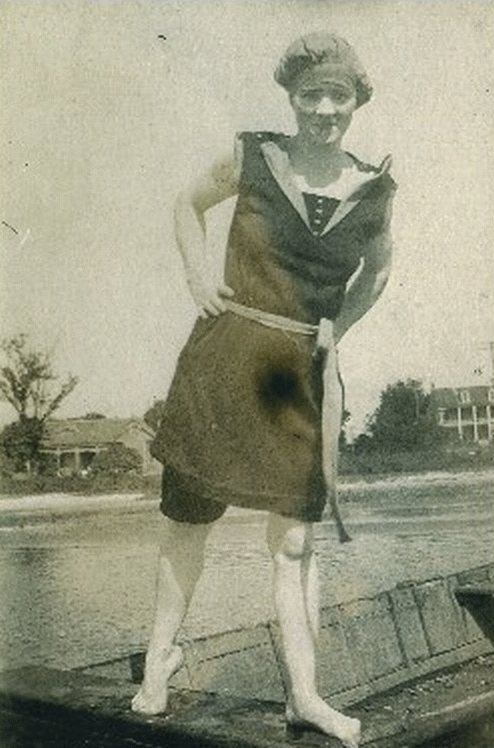 
Constance ("Tiny") Corcoran Adorno, born and raised in New
Orleans. enjoys the bayou not far from her family's Moss Street home c. 1910.
Note
the Louis Blanc House at 924 Moss Street Moss Street
in the right center-ground. The plantation style house was built c. 1798.
Thanks to Connie
Adorno Barcza for sharing this photo of her grandmother.
Photographer Clarence John Laughlin's family moved
to New Orleans in 1910 when he was five years old.
Jefferson Davis monument was erected on Canal Street at Cleveland.
820 Poydras St - The the Cumberland/Southern Bell Building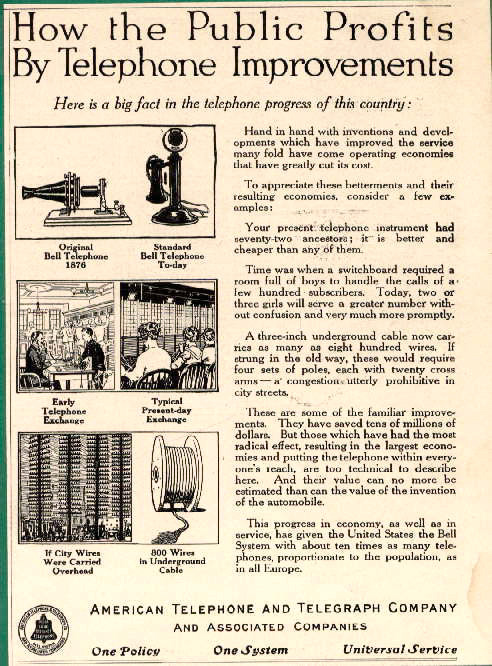 1916 telephone ad. Source: http://myinsulators.com/commokid/telephones/1910s_telephone_ads_cont.htm
   
Mayer Israel's on Canal St. was a fixture in downtown New Orleans from 1906 until it closed in the late 1950s.
As a young man, Mayer Israel entered the business of his uncle Leon Godchaux and, in 1891 purchased the clothing house of
H.D. McGown. In 1906, he moved the store to 706 Canal, and in 1910, he purchased the property at 714 Canal and had
a new structure built on the site. The store later expanded into 716 Canal as well.
Source: http://www.nutrias.org/~nopl/monthly/jan2001/jan012.htm
Krewe of Proteus Float Design circa 1905Bror Anders Wikstrom is the artist who designed
the carnival parades of the Krewe of Proteus from 1900 to 1910. View an online exhibit of his work at http://nutrias.org/~nopl/exhibits/mg2002/prointr.htm
An invitation to the Mithras ball from 1910. photo http://nutrias.org/monthly/feb97/feb97.htm
|
U.S. Mint Closes

At the corner of Esplanade Avenue (400 Esplanade) and North Peters Street near the Mississippi River sits the imposing Greek
Revival style U.S. Mint which was built in 1836. Fort St. Charles (built in 1792) had protected the north-west corner of
the original city at this site during the Spanish Colonial Period. In later years this plot of land adjacent to the French
Market was the location of the first Jackson Square in New Orleans. The branch mint was established in 1833 and opened in
1838 as the largest mint in the United States. The 282 by 81 walls are 36 inches thick at the basement level and taper to
18 inches on the third story. The exterior is composed of cemented brick topped with a Mississippi River mud plaster. During
the Civil War (in 1861) the United State of Louisiana coined Confederate currency and housed soldiers there. From 1879 through
1910 it reverted back producing U.S. currency. In 1927 through 1930 the Veterans Bureau used the building. In 1932 it served
as a federal prison for short term violators of the Volstead Act. The U.S. Coast Guard Reception Center was located there
in 1943. From 1981 until Hurricane Katrina the building was used as branch of the Louisiana State Museum. (Courtesy Library
of Congress.)

In this 1897 photograph women workers at the U.S. Mint in New Orleans inspect and weigh blank coins. Coin Adjustors (historically
always women) filed the edges of slightly overweight coins until they weighed the precise amount required; if blanks were
underweight or too heavy for filing they were returned to be re-melted and recast. Scales in adjusting rooms were so accurate
that a breath or a breeze could affect their accuracy therefore coin adjustors worked in rooms with closed doors and windows
regardless of the temperature in pre-air-conditioning days. (Courtesy Library of Congress.)
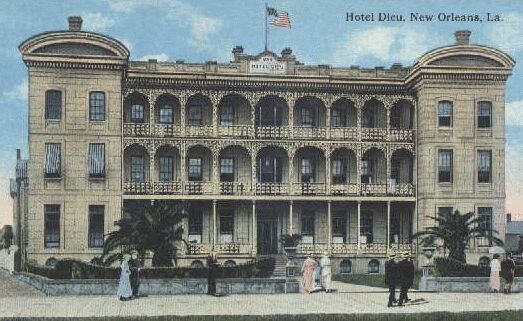
Hotel Dieu was not a hotel, but a hospital run by the Sisters of Mercy.
This postcard
circa 1910.
West End:
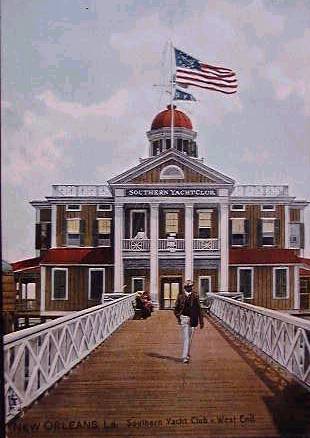
|
| Raphael Tuck & Sons Postcard view of the West End of the Southern Yacht Club. |
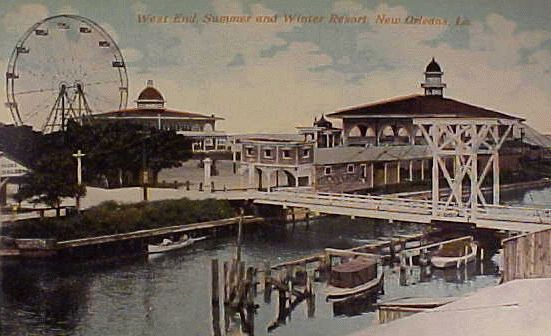
|
| New Basin Canal at West End |
'Scordill' postcard of West End summer & Winter Resort, New Orleans, LA.
Attractions include amusement rides,
Thoms Gate, & the Macki Saloon.
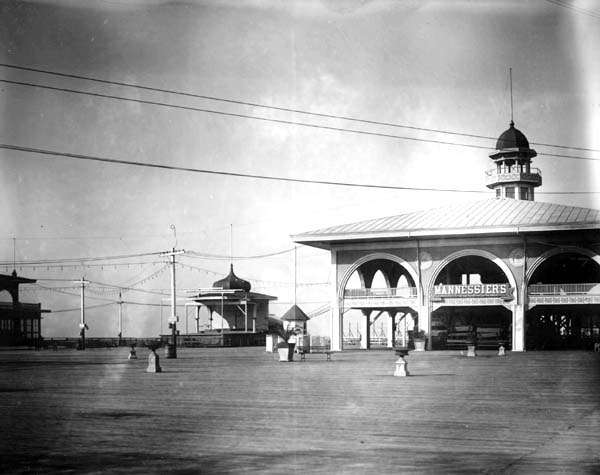
|
| Mannessier's Pavilion |

|
| Walks at West End |
Several yacht clubs and the lighthouse can be seen, as well as camps in the background. Postcard published by
Lipsher Specialty of New Orleans. The card was posted in 1910 in New Orleans.
The New Canal Light, was one of a series of octagonal wooden lighthouses built in 1838, that surrounded Lake
Pontchartrain. It was built on pilings then relocated to its present site in 1910.
John Gentilich opened the Acme Cafe at 117 Royal St. After a 1924 fire, Acme moved to the current
location at 724 Iberville St. and was re-named Acme Oyster House.
Spanish Fort:
1910 - Postcard Postcard postmarked 1910. F. M. Kirby & Company of New Orleans Louisiana issued this view of the "Old
Spanish Fort" in New Orleans.
This postcard, from about 1910, was published by C.B. Mason, of New Orleans, Louisiana. The card pictures the
Railroad Station at Spanish Fort in New Orleans. The description on the back reads, 'Historical Spanish Fort on the shores
of Lake Pontchartrain operated by the New Orleans Railway & Light Co., New Orleans, La.'
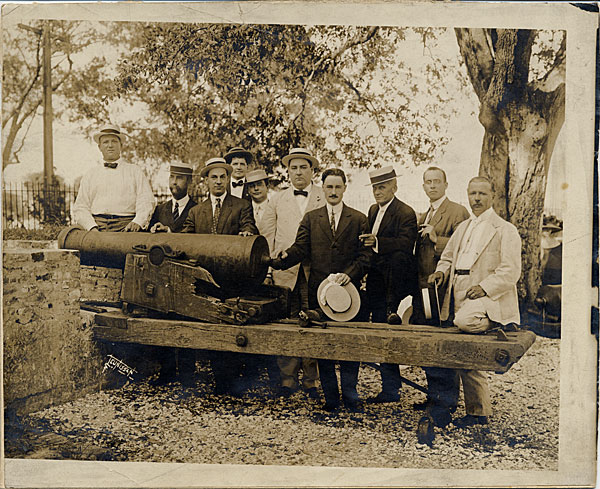
|
| Dapper Gentlemen with Canon at Spanish Fort |
Spanish Fort Ruins Title: Spanish Fort Description: Suited men standing behind a cannon at Spanish Fort. Source: Louisiana
State Museum http://appl005.lsu.edu/LSM.nsf/0d6463f4d93cecd68625689c00470f5c/664159a2e80fffbe862569f9004f91b8?OpenDocument
In 1910 all cannons at the fort were removed and placed in theLouisiana State Museum
at the Cabildo.
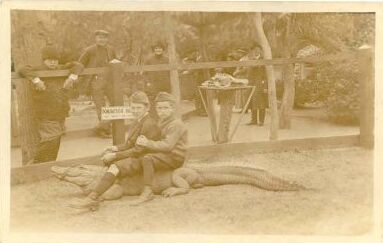
|
| Boys Riding an Alligator named Pontchartrain Bill at Spanish Fort |
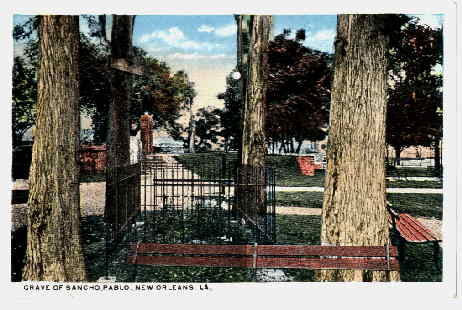
|
| Grave of Sancho Pablo at Spanish Fort |
Grave of Sancho Pablo, New Orleans, La 1910. Sancho Pablo was the first commander of Spanish Fort. Legend
has it that he was was in love with an Indian girl whose father disliked him and killed him when he discovered them meeting
under the trees where he is buried.
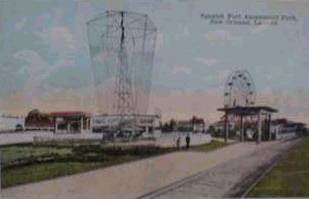
|
| Spanish Fort Amusement Park |
      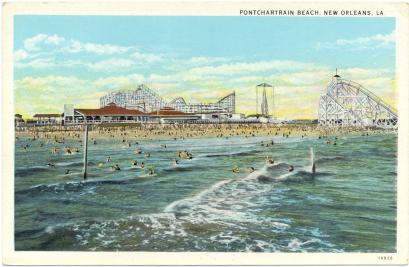
Pontchartrain Beach at Spanish Fort

|
| Spanish Fort circa 1910 |
The
Tramps, who first marched in 1901 tossing gold walnuts began handing out coconuts in 1910.
This group would later be known as The Krewe of Zulu.
1910s Jelly Roll Morton plays on the Lake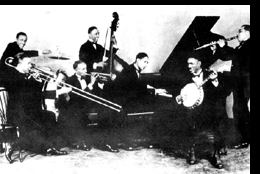 Ferdinand (Jelly Roll) Morton (1890-1941) was was the first great composers and piano players of Jazz. An interesing
quote from Jelly Roll, talking about his recordings (records): "Why would anyone be interested in those old things?"
He wrote "Pontchartrain" and recorded "Bucktown Blues". From 1926-1930, Jelly Roll Morton and the Red
Hot Peppers band included Jazz greats Baby Dodds(drums), Johnny Dodds (clarinet), Kid Ory (trombone), and Johnny St. Cyr (banjo
& guitar)--all born in New Orleans. Sources: Asbol Repertoire http://www.redhotjazz.com/jellyroll.html
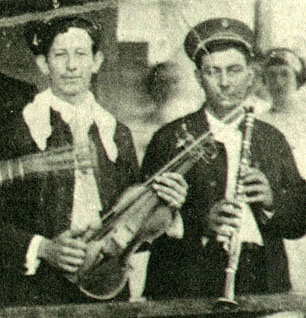 Alcide Nunez, right, with his nephew, violinist Harry Nunez, in the early 1910s. In this photo they were playing at one of
the old camps on Lake Pontchartrain with Frank Christian's Band. Nunez worked in the bands of his friends cornetist Frank
Christian and trombonist Tom Brown. At least on occasion, Nunez put together a band under his own name. But for years his
most important work was with bandleader Papa Jack Laine. Source: http://www.geocities.com/BourbonStreet/5135/NuStart.html
1884-1934 - Alcide (Yellow) Nunez The Moonlight Serenaders...played regularly along the lakefront north of New Orleans at
places like Milenburg and Little Woods. They accompanied the Boswell Sisters early in their carrer. Source: http://www.geocities.com/BourbonStreet/5135/WCBE.htm
Trombonist Tom “Red” Brown (1888-1958) played with Papa Jack Laine's Reliance band.
He organized Brown's Ragtime Band in 1910. Tom Brown and his New Orleans Jazz Band claimed to be the first to
use the word 'Jass. Brown played with Johnny Bayersdorffer and his Jazzola Novelty Orchestra. He left New
Orleans in 1915 when he took Brown's Ragtime Band to Chicago making him the first to bring a White Jazz band north from
New Orleans.
For a while, both black and white bands had found plenty of seasonal employment
at the beachfront restaurants, pavilions, and cabarets lining the south shore of 635-square-mile Lake Pontchartrain, less
than five miles north of the city. Tom Brown's band was even one of the few that got to play on the excursion steamers
that took tourists to the more exclusive north shore. But Pontchartrain's heyday ran in cycles, subject to sometimes violent
weather and changing fashion. It ended forever when, in the mid-1920s, construction began on a seawall to extend the existing
shoreline out several hundred feet, protecting it from storms and flooding--and leaving the former resort area stranded inland.
Source: http://www.nytimes.com/books/first/s/sudhalter-chords.html Like most early White New Orleans Jazz musicians, trombonist
Tom Brown was a veteran of Papa Jack Laine's Reliance. Around 1910 he organized his own band called Brown's Ragtime
Band. In 1915 he took the band North to Chicago making him the first to bring a White Jazz band north from New Orleans. Brown
claimed to be the first to use the word "Jass" to descibe the music that was coming out of New Orleans. The legend
goes like this; The word "Jass" was some vague slang for sex, and was associated with prostitution. Tom Brown's
band had come North from New Orleans in 1915 and was playing a successful engagement at Lamb's Cafe (located at Clark
and Randolph Streets) against the wishes of the Chicago musician's union. The term "Jass" was used by the union
as a way to denigrate the band. In defiance of union Brown and the club owner started advertising the band as Brown's
Band From Dixieland . The union's insults backfired increasing the popularity of the group and causing the term "Jass"
to forever to be used to describe the New Orleans style of collective improvisation. Brown's Dixieland Jass Band consisted
of Tom Brown on trombone; his brother Steve on bass, Ray Lopez on cornet; William Lambert on drums; Arnold Loyacano on guitar;
and Larry Sheilds on clarinet. The band travelled to New York and had a successful run in 1916, but then broke up. Brown returned
briefly to New Orleans, but booking agents in New York were still contacting him wanting a "Jass" band. He recommended
another White New Orleans Jazz band, Stein's Dixieland Jass Band that was playing in Chicago at the time. Johnny Stein
was under contractual obligation in Chicago and couldn't make it, but the rest of the band decided that this was to good
of an offer to pass up and left Stein holding the bag in Chicago. In New York the group became The Original Dixieland Jass
Band, an obvious attempt to associate themselves with Brown's Band From Dixieland. Brown got another band together and
got a gig at New York's Century Theatre as part of Town Topics revue in 1916 where they were billed as The Five Rubes.
Once in New York, Brown's clarinetist, Larry Sheilds exchanged jobs with Yellow Nuñez who had just been fired from
The Original Dixieland Jass Band. Nuñez joined Browns band. While in New York Tom Brown took part in a number of recording
sessions which included the Happy Six, Yerke's Jazzarimba Orchestra, The Kentucky Seranaders, and with Ray Miller's
Black and White Melody Boys. Brown couldn't keep his band together in New York, and returned to Chicago where he lead
bands and work as a sideman before he returned to New Orleans and opened a music shop. In New Orleans he played with Johnny
Bayersdorffer and his Jazzola Novelty Orchestra. He continued to play in a variety of bands in New Orleans for the rest of
his life while also running his store. In 1955 and 1958 recorded for the first time under his own name. These sessions are
avaliable on CD from GBH records under the name of Tom Brown and his New Orleans Jazz Band. Source: http://www.redhotjazz.com/brown.html
Geary “Bunk” Johnson ((1889-1949) joined the Eagle Band in 1910.
Louis Armstrong, recalled that Bunk Johnson was as one of the early influential jazz musicians in New Orleans. Honore
Dutrey started playing trombone in various bands in New Orleans in 1910 , including Jimmie Noone's band. Clarinetist
Jimmie Noone was raised in Hammond, where he began to play guitar as a boy. In 1910, his family moved to New Orleans
The Northshore:
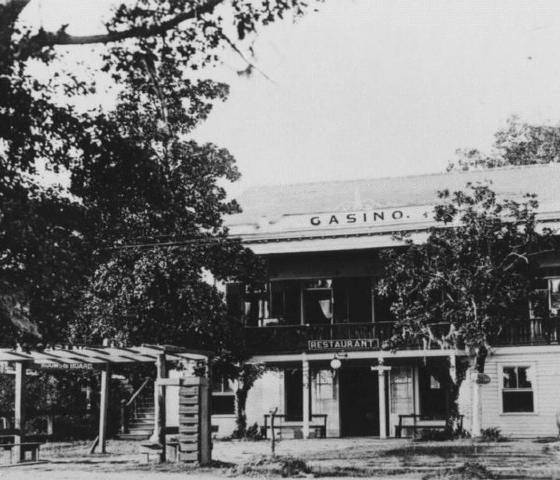
|
| Bechac's |
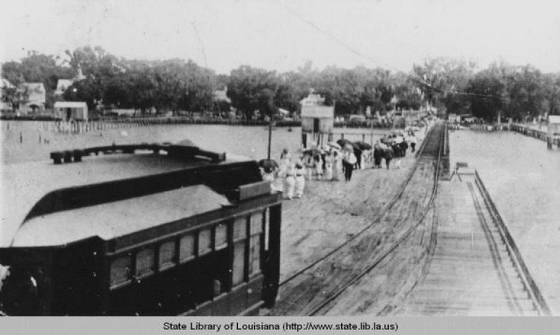
|
| Mandeville Pier and Railroad |
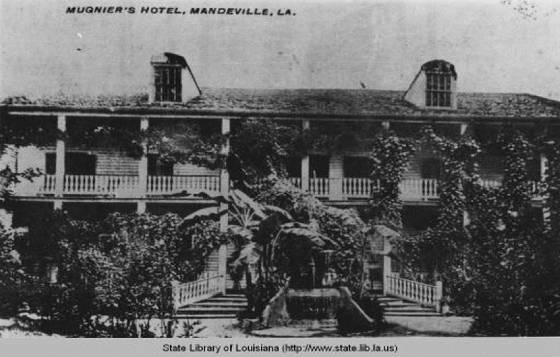
|
| Mugnier's Hotel in Mandeville |
|
